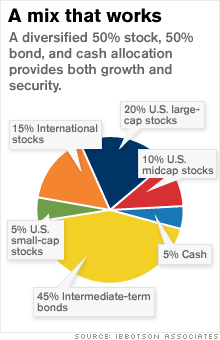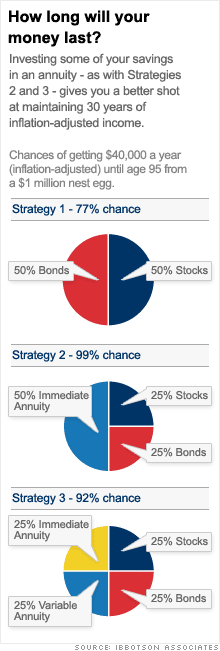How to make your money last
There are ways to guarantee you won't run out of income, regardless of what the market does next - but you'll have to make some tradeoffs to do so.


(Money Magazine) -- Once you have your Social Security strategy down, there's just one little retirement question left to consider: How can you make the money that you've so diligently saved provide the life you want for as long as you live? Oh. That.
Figuring out how to draw secure retirement income from a portfolio is a challenge in the best of times; today it's made more complicated by fear. Having seen the worst-case scenario unfold in the past year, you've probably gone into loss-avoidance mode. But deflecting market risk leaves you vulnerable to inflation risk -- and the risk that you'll outlive your money. So hiding in cash won't save you.
"No one investment can protect you from every risk you'll face," says John Ameriks, head of Vanguard Investment Counseling & Research. What you need, rather, is a basket of investments that provides:
1. Stable income you're not likely to outlive.
2. The potential for that income to grow to beat inflation.
3. The ability to access cash to meet unexpected needs.
4. Adequate protection from market downturns.
Here are three smart strategies to achieve those goals. The second offers the best chance of making your money last; however, you'll lose access to a big chunk of your savings. The others give you more control, but less certainty. There's no free lunch in retirement -- but the menu that follows presents some interesting options.
YOU'RE A CANDIDATE IF ...
You have enough income from Social Security and pensions to cover most of your basic expenses (so you could weather a market storm) and/or you're confident in your ability to manage your portfolio.
THE PREMISE: You invest in a diversified portfolio of stocks, bonds, and cash that has the potential to generate current income and capital gains. You pull out money as needed, starting off with a 4% annual withdrawal -- $40,000 on a $1 million portfolio -- then increasing the dollar amount by the inflation rate each year.
Done correctly, this gives you a 77% shot of your money lasting 30 years, says Ibbotson Associates. The higher the withdrawal rate, the lower your odds. So this strategy may not work if you need more income than 4% would provide.
THE DRAWBACKS: A sizable loss early in retirement could undo you. If your portfolio loses 20% the first year, the chances of your savings lasting 30 years could drop to roughly 50%. Alternatively, if the market does well over the long run, you could be left with a huge sum late in life, so you would have lived more frugally than you had to.
HOW TO PULL IT OFF: Allocation is key. Going 100% into bonds might protect you from a market meltdown, but such cataclysms are rare. And you'd lose out on inflation protection. Loading up on stocks gives you a better shot at increasing your income, yet you may get mauled by a bear market. So aim for the middle ground: For someone just entering retirement, a broadly diversified fifty-fifty stock-to-bond blend like the one in the chart above, right is a reasonable starting point.
You also have to be flexible with withdrawals. In a declining market you may have to skip the inflation boost or scale back the amount you draw down. Conversely, if the markets go on a run, you may be able to take more. Check yearly at T. Rowe Price's Retirement Income Calculator.
Finally, be strategic in the way you tap assets. Start with taxable accounts; then tax-deferred (401(k)s and traditional IRAs); then tax-free Roths. That way the latter accounts compound longer without the drag of taxes, so you can build bigger balances and draw more income over time.
YOU'RE A CANDIDATE IF ...
You need more income for basic expenses than you'll get from Social Security and pensions. Or you'd like to avoid subjecting all your savings to market volatility.
THE PREMISE: Invest a portion of your savings in a lifetime immediate annuity, an insurance product that will send you fixed monthly checks for as long as you and/or your spouse live. You'll manage the rest of your portfolio as in Strategy 1. The payoff: You'll have another layer of guaranteed income and still have funds to tap.
This strategy provides longer income security than the first because the payout from an immediate annuity can't be easily matched by another sure-bet investment. Recently immediate annuities paid out roughly 8% for a 65-year-old man, or about $40,000 a year on $500,000. You'd have to invest significantly more to get the same assured lifetime income from long-term Treasuries. The reason immediate annuities pay so well? Investors' money is pooled, allowing insurers to essentially transfer funds from early croakers to those who hang on past life expectancy.
THE DRAWBACKS: Once you hand over, say, a few hundred grand for an immediate annuity, you typically give up access to the money. You can't use it for a new roof or a vacation in France, or pass it down to your kids. Plus, if you're hit by a bus early in retirement, the annuity will have paid out less than you put in. For those reasons, many people perceive immediate annuities as potentially wasted money.
Another concern: Annuity payments are usually fixed, meaning they'll be worth less over time because of inflation. A few insurers offer inflation-adjusted immediate annuities, but the payouts start considerably lower.
Finally, while annuities eliminate market and longevity risk, they introduce another risk: Your income security is based on the financial health of the insurer.
HOW TO PULL IT OFF: In reality, money in an annuity is no more "wasted" than the premiums you pay to insure your house. So try to get over that psychological hurdle, since this strategy presents your best chance of maintaining income.
To make it work, you want to devote enough to the annuity so that the income, along with Social Security and pensions, covers your basic expenses. But you don't want to go overboard, as you'll lose too much liquidity. Plus, you'll need to use what's left to try to beat inflation, since your annuity payments won't.
There's no one "right" mix. Splitting savings fifty-fifty between an immediate annuity and a diversified portfolio can provide the same 4% inflation-adjusted income as in Strategy 1 -- but with a 99% chance of lasting 30 years. If you can live with less certainty, you can boost your income to, say, 4.5% by drawing more from your portfolio. Or, you could invest less in the annuity.
Consider buying in stages. That prevents you from over-committing and from investing all your money when interest rates -- which drive payouts -- are lowest. To mitigate the risk of insurer failure, stick to companies highly rated by Standard & Poor's and A.M. Best, then spread your money among two or three companies. Check at nolhga.com that the amount you'll invest with each company is covered by your state's insurance guaranty association.
YOU'RE A CANDIDATE IF ...
You need more income than Social Security and pensions will provide, but you want access to more of your savings than Strategy 2 allows.
THE PREMISE: While maintaining a stock/bond portfolio, you'll also invest a portion of savings in an immediate annuity and a portion in a variable annuity with a guaranteed lifetime withdrawal benefit (a.k.a. VA with GLWB), an investment account promising a minimum withdrawal for the rest of your life.
In a VA with GLWB, you choose the investments, within limits. You can dip into the account as needed. And you can typically leave the greater of (a) the account balance or (b) your original investment minus withdrawals to your heirs. So it's more flexible than an immediate annuity.
The other advertised benefit: Your income has the potential to grow if your investments appreciate. Say you invest $250,000 and are guaranteed 5%, or $12,500 a year. If, on your contract anniversary date, a rising market has pushed your balance to $300,000 after fees, your 5% will be applied to that amount, boosting your income to $15,000.
Even if a market crash later knocks your account to $200,000, you're still guaranteed 15 grand (though if you want to cash out, you're limited to the actual account value).
THE DRAWBACKS: Flexibility comes at a price. First, variable annuities pay significantly less than immediate annuities, only about 5% for a 65-year-old. Second, the plans come with such high fees, often 3% or more a year, that it's difficult for your account value to grow at all, let alone keep pace with inflation. Third, though you can draw more than your guaranteed amount from the account, doing so will reduce your income for future years. Last, you face the same insurer risks as in Strategy 2.
HOW TO PULL IT OFF: The high fees and low payout of the VA explain why you need an immediate annuity in the mix: Without it, the odds of maintaining your target income are slightly lower than with a stock/bond portfolio alone.
Together you want the payouts, along with Social Security and pensions, to cover your basic expenses. So how much in each? The more you put in the variable annuity vs. the immediate, the more of your assets you'll have access to.
In exchange, you'll settle for a lower guaranteed payout. A reasonable mix: Put 25% of savings into an immediate annuity, put 25% in a VA, and invest the other 50%. That gives you a 92% chance of getting the income you want for 30 years. You'll end up giving away more of your savings to fees than with the other strategies, but, alas, you have to pay for security one way or another. ![]()


